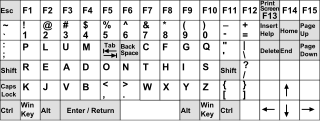 W
WAZERTY is a specific layout for the characters of the Latin alphabet on typewriter keys and computer keyboards. The layout takes its name from the first six letters to appear on the first row of alphabetical keys; that is,. Similar to the German QWERTZ layout, it is modelled on the English QWERTY layout. It is used in France and Belgium, although each of these countries has its own national variation on the layout. Luxembourg and Switzerland use the Swiss QWERTZ keyboard. Most of the residents of Quebec, the mainly French-speaking province of Canada, use a QWERTY keyboard that has been adapted to the French language such as the Multilingual Standard keyboard CAN/CSA Z243.200-92 which is stipulated by the government of Quebec and the Government of Canada.
 W
WThe Blickensderfer Typewriter was invented by George Canfield Blickensderfer (1850–1917) and patented on August 4, 1891. Blickensderfer was the nephew of the inventor of the stenotype John Celivergos Zachos. Two models were initially unveiled to the public at the 1893 World's Columbian Exposition in Chicago, the Model 1 and the Model 5. His machines were originally intended to compete with larger Remington, Hammond and Yost typewriters, and were the first truly portable, full-keyboard typewriters. The design also enabled the typist to see the typed work at a time when most typewriters were understrike machines that concealed the writing. When Blickensderfer unveiled his small Model 5 at the 1893 World's Fair, a stripped-down version of his larger more complex Model 1 machine, these revolutionary features attracted huge crowds and a full order book – many of them from Britain, Germany and France, whose business machine markets were more highly developed than the United States.
 W
WColemak is a keyboard layout for Latin-script alphabets, created by and named after Shai Coleman in 2006. The layout is designed to make typing more efficient and comfortable by placing the most frequent letters on the home row.
 W
WThe CSA keyboard, or CAN/CSA Z243.200-92, is the official keyboard layout of Canada. Often referred to as ACNOR, it is best known for its use in the Canadian computer industry for the French ACNOR keyboard layout, published as CAN/CSA Z243.200-92.
 W
WDvorak is a keyboard layout for English patented in 1936 by August Dvorak and his brother-in-law, William Dealey, as a faster and more ergonomic alternative to the QWERTY layout. Dvorak proponents claim that it requires less finger motion and as a result reduces errors, increases typing speed, reduces repetitive strain injuries, or is simply more comfortable than QWERTY.
 W
WEurKEY is a multilingual keyboard layout which is intended for Europeans, programmers and translators and was developed by Steffen Brüntjen in 2017 and published under the GPL free software license. It is available for common desktop operating systems such as Windows, Mac OS X and GNU/Linux.
 W
WHCESAR is an obsolete Portuguese typewriter keyboard layout. It was created by decree on July 17, 1937, under Portuguese prime minister António Salazar. The purpose of the layout was to place the most frequently used characters, as they were used in Portuguese, in the center of the layout.
 W
WThe Icelandic keyboard layout is a national functional keyboard layout described in ÍST 125, used to write the Icelandic language on computers and typewriters. It is QWERTY-based and features some influences from the continental Nordic layouts. It supports the language's many special letters, some of which it shares with the other Nordic languages:Þ/þ, Ð/ð, Æ/æ and Ö/ö These are all entered by pressing dedicated keys Þ Ð Æ Ö. Á/á, É/é, Ý/ý, Ú/ú, Í/í, and Ó/ó are entered by first pressing dead key ´ located to the right of Æ and then the corresponding key.
 W
WThe Neo layout is an optimized German keyboard layout developed in 2004 by the Neo Users Group, supporting nearly all Latin-based alphabets, including the International Phonetic Alphabet, the Vietnamese language, some Cyrillic languages.
 W
WThe PLUM keyboard is a computer keyboard which varies from the traditional QWERTY keyboard in both physical key layout and letter arrangement. Unlike most keyboards, the PLUM keyboard organizes keys in a square grid, as opposed to the staggered rows of a typewriter. Though the Plum Keyboard is currently off-line, it is still being promoted.
 W
WThere are two QWERTY-based keyboard layouts used for the Portuguese language.
 W
WQWERTY is a keyboard design for Latin-script alphabets. The name comes from the order of the first six keys on the top left letter row of the keyboard. The QWERTY design is based on a layout created for the Sholes and Glidden typewriter and sold to E. Remington and Sons in 1873. It became popular with the success of the Remington No. 2 of 1878, and remains in ubiquitous use.
 W
WThe QWERTZ or QWERTZU keyboard is a typewriter and keyboard layout widely used in Central Europe. The name comes from the first six letters at the top left of the keyboard:.
 W
WThe current Romanian National Standard SR 13392:2004 establishes two layouts for Romanian keyboards: a "primary" one and a "secondary" one.
 W
WA keyboard layout is any specific physical, visual or functional arrangement of the keys, legends, or key-meaning associations (respectively) of a computer keyboard, mobile phone, or other computer-controlled typographic keyboard.